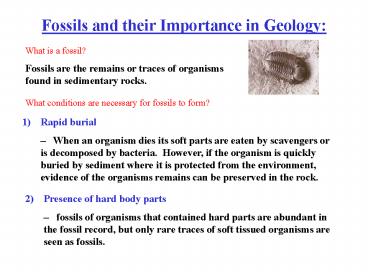Fossils and their Importance in Geology: PowerPoint PPT Presentation
1 / 6
Title: Fossils and their Importance in Geology:
1
Fossils and their Importance in Geology
What is a fossil? Fossils are the remains or
traces of organisms found in sedimentary rocks.
What conditions are necessary for fossils to form?
- Rapid burial
- When an organism dies its soft parts are
eaten by scavengers or is decomposed by bacteria.
However, if the organism is quickly buried by
sediment where it is protected from the
environment, evidence of the organisms remains
can be preserved in the rock.
- Presence of hard body parts
- fossils of organisms that contained hard
parts are abundant in the fossil record, but only
rare traces of soft tissued organisms are seen as
fossils.
2
Fossils and their Importance in Geology
What is the importance of fossils to geologist?
And what does a fossil indicate?
- Fossils indicate the age of sedimentary
rocks. The age of the rock can be narrowed down
if we know when a life form existed on Earth.
- Fossils indicate the environments in which rocks
formed. Remains of life can indicate what
ancient climates were like in the past. For
example, fossils of coral indicate a warm
tropical environment.
3) Fossils are used to correlate (match up)
rocks. One of the best places to study this is
in the Grand Canyon. Fossils were discovered
that show a time span of millions of years.
3
Fossils and their Importance in Geology
What is the importance of fossils to geologist?
And what does a fossil indicate?
4) Fossils provide the basis by which the
subdivisions of the Geologic Timescale are
divided. Each division of the Geologic
timescale is marked by some significant event in
the evolution of Earth. Fossils often indicate
these events and provide evidence to subdivide
geologic time. For example, extinctions marked
the end of two eras the extinction of trilobites
and other marine organisms marked the end of the
Paleozoic Era and the extinction of dinosaurs
marked the end of the Mesozoic Era.
5) Fossils can also indicate evolutionary
pathways. Fossil evidence show the progression
(evolution) of life forms with time.
4
Fossils Indicate Evolutionary Pathways
- Precambrian
- Little direct evidence of fossils, due to lack of
hard body parts. - Fossil evidence include algae, bacteria, and
traces of soft body organisms.
- Paleozoic Era -- Age of the Invertebrate.
- Invertebrates evolved into vertebrates
- First land plants evolved in the Silurian.
- Abundance of fishes in the Devonian which is
known as the age of the fishes. - Lung fish evolved into amphibians throughout the
the Mississippian and Pennsylvanian. - Amphibians evolved into reptiles in the Permian
and reptiles are known as the first true land
dwellers. Hard shelled eggs made this possible. - Mass extinctions of invertebrates including
trilobites and numerous other marine species
occurred at the end of the Paleozoic Era.
5
Fossils Indicate Evolutionary Pathways
- Mesozoic Era -- Age of the Reptiles
- Dinosaurs became dominant.
- First birds are seen during this time
- The end of the Mesozoic Era was marked by mass
extinctions of reptiles including dinosaurs and
numerous other species.
- Cenozoic Era -- Age of the Mammals.
- Mammals evolve and dominate during this time.
- Flowering plants are the dominant land plant.
- Some mammals became extinct during the late
Cenozoic (11,000 years ago). These include the
mastodon, mammoth, saber-tooth cat, large ground
sloth, giant bison and others.
6
Fossils Indicate Evolutionary Pathways
Invertebrates Fish Amphibians Reptiles -
Mammals

